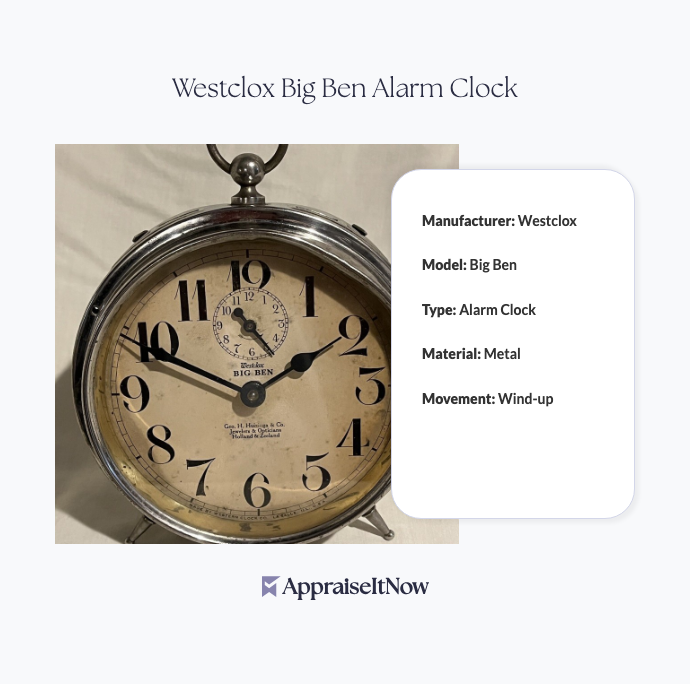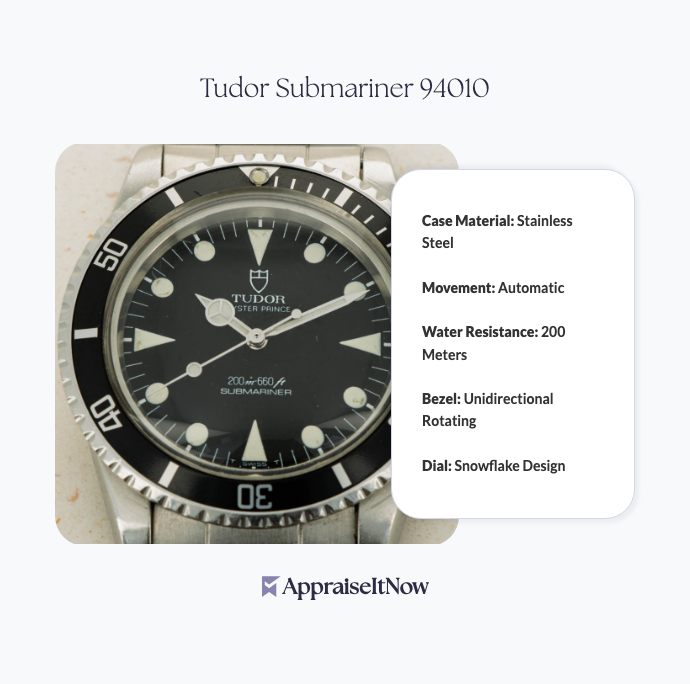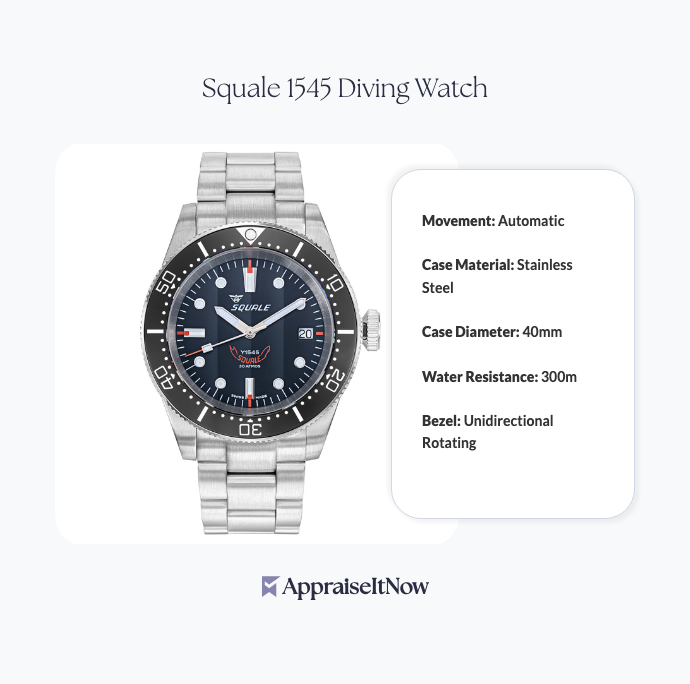<h1>How to Get Your Westclox Big Ben Alarm Clock Appraised</h1>
<p>The Westclox Big Ben Alarm Clock stands as one of America's most iconic timepieces, with values ranging from <strong>$50 to $200</strong> depending on condition, rarity, and mechanical function. Whether you've inherited a vintage piece, discovered one at an estate sale, or are simply curious about what your clock is worth, understanding the appraisal process helps you make informed decisions about this timeless piece of <a href="/types/memorabilia-and-collectibles">memorabilia and collectibles</a>.</p>
<h2>Why Your Westclox Big Ben Holds Value</h2>
<p>Introduced in <strong>1908</strong>, the Westclox Big Ben revolutionized household alarm clocks with its distinctive bell-shaped design and remarkably loud, dependable alarm. This wasn't just another timepiece—it became a cultural touchstone, appearing in countless homes, movies, and advertisements throughout the 20th century. The clock's reputation for mechanical reliability means many examples remain functional today, a quality that resonates deeply with collectors and vintage enthusiasts alike.</p>
<p>The Big Ben's value stems from several converging factors. Its <strong>accurate mechanical movement</strong> proved far superior to many competitors of its era, while the <strong>sturdy metal construction</strong> ensures survival through decades of use. These practical virtues combined with nostalgic appeal create sustained collector interest. When you ask yourself "How do I know if my clock is valuable?", understanding that working condition and original components significantly increase worth becomes your first insight into appraisal considerations.</p>
<div class="callout tip"><p><strong>Collector's Insight</strong></p>
<p>A Big Ben with original packaging, documentation, or matching accessories can command 30-50% premiums over standalone examples in the current market.</p></div>
<h2>Identifying Your Westclox Big Ben's Characteristics</h2>
<h3>Determining Age and Model Variations</h3>
<p>One of the most common questions collectors ask is "When was Westclox Big Ben made?" While the iconic design debuted in 1908, production continued for decades with numerous variations. Dating your specific clock requires examining several identifying features. The model number, typically found on the back or bottom of the case, provides the clearest indication of manufacture period. Earlier models feature simpler mechanisms and painted finishes, while later versions introduced chrome plating and improved electrical components.</p>
<p>The question "How do you date a Westclox alarm clock?" has practical importance for appraisal purposes. Serial numbers, patent dates stamped on the mechanism, and design elements like bell configuration all contribute to establishing authenticity and age. Professional appraisers specializing in <a href="/types/antiques">antiques</a> use this forensic approach to validate your clock's pedigree and marketplace positioning.</p>
<h3>Understanding the Bell-Shaped Design</h3>
<p>The Big Ben's signature bell-shaped case isn't merely aesthetic—it's engineered for acoustic performance. The design amplifies the alarm's sound, answering the question "Is the Westclox alarm loud?" with an emphatic yes. This deliberate engineering choice means original examples with intact bells command higher valuations than examples where the bells have been dented, removed, or replaced. The case construction also influences value; stamped steel examples differ substantially in worth from cast iron variants produced in specific production periods.</p>
<h2>Condition Assessment and Appraisal Factors</h2>
<p>When seeking professional appraisal services, appraisers evaluate several specific condition markers that directly impact your Westclox Big Ben's value. The aesthetic condition of the metal case—whether the original finish remains intact or shows patina, rust, or refinishing—represents a major value determinant. Unlike concerns about whether <a href="/types/personal-property">personal property</a> deteriorates quickly, well-constructed Big Bens age gracefully, with aged finishes often preferred by sophisticated collectors over aggressive restoration.</p>
<p>The mechanical condition proves equally important. A Big Ben in working order with all original components typically valued <strong>20-40% higher</strong> than non-functional examples. This explains why appraisers specifically ask "How to set a vintage Westclox alarm clock?" and "Does the Big Ben clock still work?"—these questions establish mechanical viability and user functionality that appeal to working-condition collectors. The movement's ability to keep accurate time and produce its signature alarm sound represents tangible value to buyers.</p>
<table class='appraisal-table'>
<thead>
<tr>
<th>Condition Factor</th>
<th>Impact on Value</th>
<th>Details</th>
</tr>
</thead>
<tbody>
<tr>
<td>Case finish</td>
<td>±30%</td>
<td>Original paint/chrome vs. refinished</td>
</tr>
<tr>
<td>Bell integrity</td>
<td>±25%</td>
<td>Original bells vs. replaced/damaged</td>
</tr>
<tr>
<td>Mechanical function</td>
<td>±40%</td>
<td>Working movement vs. non-functional</td>
</tr>
<tr>
<td>Original components</td>
<td>±20%</td>
<td>All original vs. parts replaced</td>
</tr>
<tr>
<td>Packaging/documentation</td>
<td>±15%</td>
<td>Original box, papers, accessories</td>
</tr>
</tbody>
</table>
<h2>Rarity Factors That Influence Valuation</h2>
<p>The Big Ben's longevity means multiple production runs created both common and scarce variants. Specific model numbers, color variations, and dial designs from particular manufacturing periods command premium pricing. A 1920s-era Big Ben differs substantially in collector value from a 1950s variant, making precise dating crucial for accurate appraisal. Additionally, examples with unusual features—such as different bell arrangements, non-standard colors, or special promotional editions—often surprise owners with higher valuations than they anticipated.</p>
<div class="callout note"><p><strong>Market Dynamics</strong></p>
<p>Unlike mass-produced items where age automatically decreases value, vintage Westclox clocks often appreciate as working examples become scarce and collecting communities grow.</p></div>
<h2>Preparing Your Clock for Professional Appraisal</h2>
<p>Before submitting your Westclox Big Ben for professional evaluation, you can take several preparatory steps that facilitate accurate appraisal. Gentle cleaning with a soft brush removes surface dust without damaging patina or original finishes. Document the clock's current condition with clear photographs from multiple angles, capturing the dial, case markings, and back plate clearly. If you have any original documentation, boxes, or receipts indicating purchase date or previous ownership, gather these materials as they substantially enhance provenance documentation.</p>
<p>When considering "How to set alarm on Big Ben clock?" or "How to wind an antique clock without a key?"—these operational questions matter less for appraisal than understanding the mechanical completeness. A professional appraiser needs to verify all components exist, whether the clock functions or not. Attempting repairs before appraisal often proves counterproductive; many collectors specifically value unrestored examples, so leave mechanical intervention to the professionals conducting the appraisal.</p>
<h2>Navigating Historical Questions About Your Clock</h2>
<p>Collectors frequently encounter questions about clock history that indirectly affect appraisal value. The question "Who makes Big Ben alarm clocks?" reflects interesting timing—while Westclox produced the iconic Big Ben, other manufacturers created competing designs. Understanding that "Big Ben" specifically refers to the Westclox design (not the London clock tower, despite the name's origin) establishes collectibility parameters. The distinction matters because naming confusion sometimes affects market searches and comparable sales identification, which appraisers rely upon for valuation benchmarking.</p>
<p>Historical research reveals fascinating details about Westclox's trajectory. When asked "What happened to Westclox?" collectors discover the company evolved through multiple ownership changes and eventually ceased independent operation, making earlier Big Ben production runs increasingly scarce. This corporate history directly supports valuation arguments for models from Westclox's peak manufacturing periods.</p>
<div class="callout tip"><p><strong>Research Value</strong></p>
<p>Documenting your clock's manufacturing period through Westclox historical records can increase appraisal credibility and your confidence in the valuation result.</p></div>
<h2>Professional Appraisal Services for Westclox Big Ben Clocks</h2>
<p>When you're ready to obtain a certified appraisal, choosing the right appraiser matters substantially. You'll want professionals experienced in <a href="/types/household-goods">household goods</a> and vintage mechanical items who understand the specific factors that influence Big Ben valuations. AppraiseItNow connects you with credentialed appraisers (AAA, ISA, ASA, CAGA, AMEA certified) who specialize in <a href="/blog/what-you-need-to-know-about-personal-property-appraisals">personal property appraisals</a> and collectible items.</p>
<p>The appraisal process begins with detailed examination and documentation. Professional appraisers photograph your clock thoroughly, note all markings and serial numbers, test mechanical function, and research comparable sales to establish fair market value. This documentation proves essential whether you're insuring the piece, settling an estate, or preparing for sale. For guidance on preparing for the appraisal experience, our resources on <a href="/blog/how-to-prepare-for-a-personal-property-appraisal">personal property appraisal preparation</a> offer practical steps that streamline the process.</p>
<h2>Insurance and Documentation Considerations</h2>
<p>Understanding your Big Ben's current value becomes critically important if you want to ensure it's properly insured. A clock valued at $150 might seem modest, but many collectors accumulate multiple pieces creating substantial aggregate value. Professional appraisals provide the documentation insurers require for <a href="/blog/everything-you-need-to-know-about-insuring-your-memorabilia-and-collectibles">collectibles and memorabilia coverage</a>, ensuring replacement cost reflects current market values rather than outdated estimates.</p>
<p>Beyond insurance, appraisal documentation supports estate planning, donation valuation for tax purposes, and sales transactions. When selling through auction houses or private collectors, a professional appraisal report enhances buyer confidence and often justifies higher asking prices by providing third-party validation of condition and authenticity. This distinction mirrors the value professional appraisals provide for <a href="/types/antique-furniture">antique furniture</a> and other vintage items where buyer skepticism requires documented proof of condition and provenance.</p>
<h2>Collecting Westclox Big Ben Clocks as an Investment</h2>
<p>Your single Big Ben might be the beginning of a broader collecting interest. Understanding appraisal principles applies equally whether you own one clock or dozens. Serious collectors maintain detailed condition records and periodic professional appraisals to track portfolio appreciation and ensure adequate insurance coverage. The nostalgia factor driving Big Ben value ensures sustained collector interest, particularly as generational memory of these iconic clocks deepens their cultural significance.</p>
<p>The broader question "Why is the Big Ben special?" encompasses both mechanical excellence and cultural resonance. Big Bens appeared prominently in films, literature, and home interiors, creating emotional connections that drive collector motivation beyond mere mechanical function. This cultural dimension adds a layer of value beyond what basic condition assessment might suggest, making professional appraisal expertise particularly valuable for understanding your specific clock's market position.</p>
<div class="callout note"><p><strong>Key Takeaway</strong></p>
<p>A professional appraisal of your Westclox Big Ben Alarm Clock provides certified documentation of value, condition, and authenticity that serves your interests whether you're buying, selling, insuring, or simply understanding what your inherited timepiece is worth in today's market. At <strong>AppraiseItNow</strong>, credentialed appraisers use USPAP-compliant standards to deliver accurate valuations you can trust.</p></div>







.avif)







